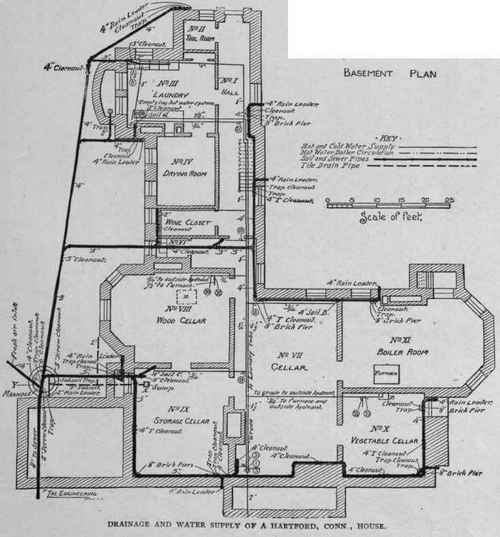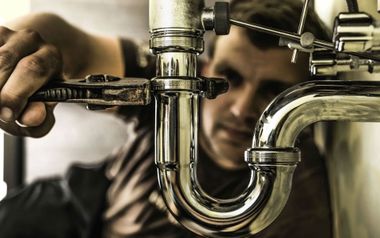The Basics to Your Home's Plumbing System Anatomy
The Basics to Your Home's Plumbing System Anatomy
Blog Article
Nearly everybody seems to have their own unique thinking on the subject of Exploring Your Homes Plumbing Anatomy.

Recognizing how your home's plumbing system works is necessary for every property owner. From supplying tidy water for drinking, cooking, and bathing to safely removing wastewater, a well-kept plumbing system is critical for your family members's wellness and comfort. In this comprehensive guide, we'll explore the detailed network that makes up your home's plumbing and offer pointers on maintenance, upgrades, and managing common issues.
Intro
Your home's pipes system is greater than just a network of pipes; it's a complicated system that guarantees you have accessibility to tidy water and effective wastewater elimination. Understanding its elements and how they collaborate can assist you stop expensive repair work and guarantee whatever runs efficiently.
Standard Components of a Plumbing System
Pipes and Tubing
At the heart of your plumbing system are the pipelines and tubing that bring water throughout your home. These can be constructed from various products such as copper, PVC, or PEX, each with its benefits in regards to durability and cost-effectiveness.
Fixtures: Sinks, Toilets, Showers, etc.
Fixtures like sinks, bathrooms, showers, and bath tubs are where water is made use of in your house. Recognizing just how these components link to the plumbing system helps in diagnosing problems and intending upgrades.
Shutoffs and Shut-off Points
Valves regulate the circulation of water in your pipes system. Shut-off shutoffs are critical throughout emergencies or when you require to make fixings, permitting you to separate parts of the system without interrupting water flow to the whole residence.
Water System
Key Water Line
The primary water line links your home to the municipal water supply or a private well. It's where water enters your home and is distributed to various fixtures.
Water Meter and Stress Regulatory Authority
The water meter procedures your water usage, while a pressure regulator ensures that water moves at a safe pressure throughout your home's pipes system, preventing damages to pipelines and components.
Cold Water vs. Warm water Lines
Recognizing the difference between cold water lines, which provide water straight from the primary, and hot water lines, which lug warmed water from the hot water heater, helps in troubleshooting and planning for upgrades.
Drainage System
Drain Pipes Water Lines and Traps
Drain pipes bring wastewater away from sinks, showers, and commodes to the drain or septic tank. Catches avoid sewer gases from entering your home and likewise trap debris that could trigger clogs.
Air flow Pipes
Air flow pipes permit air into the drain system, preventing suction that might slow water drainage and cause catches to empty. Proper air flow is important for keeping the honesty of your plumbing system.
Importance of Appropriate Water Drainage
Guaranteeing correct drainage protects against backups and water damages. Frequently cleaning drains and keeping traps can prevent expensive repairs and prolong the life of your pipes system.
Water Heater
Kinds Of Hot Water Heater
Water heaters can be tankless or traditional tank-style. Tankless heating units heat water on demand, while tanks store heated water for prompt use.
Updating Your Plumbing System
Factors for Updating
Upgrading to water-efficient components or changing old pipes can enhance water top quality, decrease water costs, and enhance the value of your home.
Modern Plumbing Technologies and Their Advantages
Discover innovations like clever leak detectors, water-saving commodes, and energy-efficient water heaters that can conserve cash and minimize ecological impact.
Price Considerations and ROI
Determine the in advance prices versus lasting savings when thinking about pipes upgrades. Many upgrades spend for themselves via reduced energy bills and fewer fixings.
How Water Heaters Connect to the Plumbing System
Recognizing how water heaters attach to both the cold water supply and warm water distribution lines assists in diagnosing problems like not enough warm water or leakages.
Maintenance Tips for Water Heaters
On a regular basis flushing your water heater to remove debris, examining the temperature settings, and checking for leakages can prolong its life expectancy and boost energy performance.
Common Plumbing Issues
Leaks and Their Reasons
Leakages can occur due to aging pipelines, loosened installations, or high water stress. Resolving leaks quickly avoids water damages and mold and mildew growth.
Blockages and Obstructions
Blockages in drains pipes and commodes are usually caused by flushing non-flushable items or a buildup of oil and hair. Using drain screens and bearing in mind what drops your drains pipes can avoid blockages.
Indications of Plumbing Troubles to Expect
Low tide stress, sluggish drains, foul odors, or unusually high water bills are signs of potential pipes troubles that need to be resolved immediately.
Plumbing Upkeep Tips
Normal Inspections and Checks
Set up yearly plumbing evaluations to catch concerns early. Seek indicators of leakages, rust, or mineral accumulation in faucets and showerheads.
DIY Upkeep Tasks
Basic tasks like cleaning faucet aerators, checking for bathroom leaks utilizing dye tablets, or insulating revealed pipes in cold environments can prevent significant plumbing concerns.
When to Call a Specialist Plumbing
Know when a pipes issue calls for professional knowledge. Trying intricate repair work without correct understanding can bring about more damages and greater repair work expenses.
Tips for Reducing Water Use
Easy habits like dealing with leaks promptly, taking much shorter showers, and running complete loads of laundry and recipes can save water and lower your energy expenses.
Eco-Friendly Plumbing Options
Take into consideration sustainable pipes products like bamboo for flooring, which is durable and green, or recycled glass for counter tops.
Emergency Preparedness
Actions to Take Throughout a Plumbing Emergency situation
Know where your shut-off valves lie and how to shut off the water in case of a burst pipeline or major leakage.
Value of Having Emergency Contacts Helpful
Maintain get in touch with information for neighborhood plumbings or emergency situation services easily offered for quick response during a pipes crisis.
Ecological Influence and Conservation
Water-Saving Components and Devices
Installing low-flow taps, showerheads, and toilets can substantially lower water use without compromising efficiency.
DIY Emergency Fixes (When Relevant).
Short-term fixes like utilizing air duct tape to patch a dripping pipeline or putting a pail under a trickling faucet can lessen damages up until an expert plumbing technician arrives.
Final thought.
Recognizing the makeup of your home's plumbing system equips you to maintain it successfully, conserving money and time on repairs. By following routine upkeep regimens and staying informed about contemporary pipes modern technologies, you can guarantee your pipes system operates effectively for many years to find.
HOW YOUR PLUMBING SYSTEM WORKS
Which Pipes Do What?
Blue lines = fresh water supply entering the building Red lines = hot water supply entering the building Grey lines = pipes carrying waste away from the building and venting pipes carrying gases away from the building (through the roof) YOUR MAIN PLUMBING SYSTEMS
There are two main plumbing systems that support your home s basic plumbing needs one that brings clean water into your home, and one that sends dirty water away from your home. Connected to the toilet, bath, shower, and other faucets in your home, these two systems keep your water flowing in the right directions.
ACCESSING FRESH WATER
Fresh and clean water is brought into your home through the main water supply line . Filtered through one pipe, this water is pressured to flow into the various fixtures in your home at any given time.
This water can be sourced from a well located on your property, a pond or river (mostly cottages), or, as in most cases, from the city s municipal water treatment centre. However, it is important to note that water that is untreated, such as the water siphoned from ponds or rivers, may not be safe to drink. Personal water supplies always need to be treated for hardness and contaminants before consumed.
MUNICIPAL WATER SUPPLIES
Improve taste and odour Remove sediment Eliminate hardness Reduce chlorine COLD WATER SUPPLY VS. HOT WATER SUPPLY
Cold water flows into your home or building through the service line, which then distributes hot or cold water to your fixtures. This line is most commonly run through a central column that runs floor to floor. Hot water runs in short and straight pipes as the longer the pipeline, the more heat that will be lost in the transfer. Having shorter pipes also allows residents to access hot water more quickly.
WASTE WATER SYSTEM
Your wastewater system is divided into two parts pipes that send wastewater away from your home and venting pipes that send sewer gas away from your home. Sewage water travels through pipes that flush the water and waste towards local sewers that are operated and managed by your city or town. Most sewer systems rely on gravity to move the wastewater to where it needs to go.
The further away from your toilet or sink, the larger wastewater pipes become. This allows for waste to be disposed of from various parts of your home or business at once without pipe blockages. The angle and flow of these pipes are also essential for keeping your waste pipes clear of build up.
https://harrisplumbing.ca/how-your-home-plumbing-system-works/

I am very fascinated by Understanding Your Home's Plumbing Anatomy and I am assuming you enjoyed our post. Sharing is nice. One never knows, you will be doing someone a favor. Thanks a lot for your time spent reading it.
Schedule And Pricing Report this page